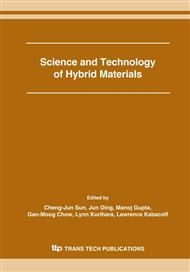[1]
A. Gök and B. Sari: J. of Appl. Polym. Sci. Vol. 84 (2002), p. (1993)
Google Scholar
[2]
G.S. Misra: Introductory Polymer Chemistry (Wiley Eastern, New Delhi 1993).
Google Scholar
[3]
J.C. Chiang and A.G. MacDiarmid: Synth. Met. Vol. 13 (1986), p.193
Google Scholar
[4]
D. Abraham, A. Bharathi and S.V. Suramanyam: Polym. Commun. Vol. 37 (1996), p.5295
Google Scholar
[5]
Instruction Manual (Scientific Equipments and Services, Roorkee, India 2000).
Google Scholar
[6]
M.Z. Ab.Rahman, A. Kassim and F. Mohammad: Chem. Environ. Res. Vol. 10(1&2) (2001), p.89
Google Scholar
[7]
A.B. Samoa, A.S. Partaker, R.S. Astute and P.C. Dev: Synth. Met. Vol. 125 (2002), p.423
Google Scholar
[8]
V.M. Mzenda, S.A. Goodman, F.D Auret and L.C. Prinsloo: Synth. Met. Vol. 127 (2002), p.279
Google Scholar
[9]
A.G. MacDiarmid: Synth. Met. Vol. 125 (2002), p.11
Google Scholar
[10]
A. J. Heeger: Synth. Met. Vol. 125 (2002), p.23
Google Scholar
[11]
A. Al-Ahmed, F. Mohammad and M.Z. Ab.Rahman: Synth. Met. Vol. 144 (2004), p.29 Fig.1 Isothermal stability of polyaniline: nylon-6,6 (ID no.9) in terms of dc electrical conductivity retention at 50, 70, 90, 110 and 130 o C. Fig. 2 Stability of polyaniline:nylon-6,6 (ID no.9) in terms of dc electrical conductivity retention by cyclic technique.
DOI: 10.1016/j.synthmet.2004.01.007
Google Scholar


